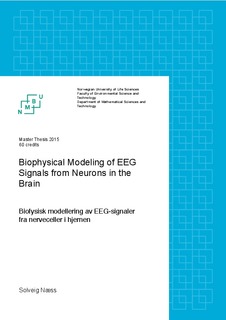| dc.description.abstract | In order to understand the link between brain signal recordings, such as electrocorticography (ECoG) and electroencephalography (EEG), and the undellying neural activity, neuroinformatics tools play an important role. A great example of such a tool is the open-source Python package, LFPy, which can be used for numerical calculations of extracellular potentials, based on a well-established compartment-based forward-modeling scheme. In this project, detailed biophysical modeling was used to gain a better understanding of contributions from single neurons to measurable extracellular potentials. In particular, we addressed the following questions: How do single neurons contribute to ECoG and EEG signals? And can these signals be modeled with the current dipole approximation? Python tools for calculating neural axial currents and the current dipole moment of a neuron were developed, and further built on to calculate extracellular potentials from the current dipole approximation. These methods, in addition to the above-mentioned compartment-based forward model, were used for studying extracellular potentials from single-cell simulations. The two different models give similar results for computations of extracellular recordings from virtual electrodes placed several millimeters away from the neuron source. Thus, the dipole approximation cannot be used for predicting single-cell contributions to ECoG signals, since ECoG recordings are measured only some hundred micrometers away from the neuron. For modeling of single-cell EEG contributions, on the other hand, the current dipole approxima-
tion appears to be applicable.
SAMMENDRAG:
For å forstå sammenhengen mellom elektrisk aktivitet i nervecellene i hjernen og målinger som elektrokortikografi (ECoG) og elektroencefalogram (EEG), er informatikkverktøy en viktig bidragsyter. LFPy er et godt eksempel på et slikt verktøy, utviklet som en tilleggspakke i Python med åpen kildekode. Blant annet kan LFPy brukes til å regne ut elektriske potensialer med utgangspunkt i en veletablert metode for compartment-basert direkte modellering. I denne oppgaven blir detaljert biofysisk modellering av enkeltnerveceller brukt til å undersøke hvordan disse bidrar til målbare ekstracellulære potensialer. Særlig belyses følgende spørsmål: På hvilken måte bidrar enkeltnerveceller til ECoG- og EEG-signaler? Og kan disse signalene modelleres ved hjelp av strømdipolmoment-tilnærmingen? Python-verktøy for utregning av nevrale aksial-strømmer og strømdipolmoment fra nerveceller ble utviklet og videre brukt til å implementere dipol-basert direkte modellering i Python. Dette kan, sammen med den ovennevnte compartment-baserte modelleringsmetoden, brukes til å undersøke bidraget til ECoG- og EEG-signaler fra enkelthjerneceller. Resultatene fra de to forskjellige modellene viste seg å være like når målepunktene ble plassert flere millimeter unna nervecellen. Følgelig kan ikke strømdipolmoment brukes til å modellere enkeltcellebidrag til ECoG-signaler, siden nervecellen her ligger kun noen hundre mikrometer unna målepunktet. Bidrag til EEG-signaler kan derimot i stor grad forutsies ved hjelp av strømdipol-tilnærmingen. | nb_NO |
